| |
BACKGROUND
The Irwin-Williams Legacy
In 1962, 1964 and 1966, C. Irwin-Williams, working at times with J. Armenta Camacho of the University of Puebla, excavated the Hueyatlaco site as part of a Valsequillo Project (Figure 1) (Irwin and Armenta Camacho, 1963). Altogether they had located four sites in 1962, including Hueyatlaco, where a number of stone artifacts had been found in situ, all associated with extinct fossil vertebrates. From the articulated remains and the proximity of the artifacts, Irwin-Williams interpreted many of these localities to be preserved "kill sites." These discoveries and their stratigraphic context were described in some detail in unpublished, open file progress reports submitted to the Instituto Nacional de Antropología e Historia (INAH), Mexico City (Irwin-Williams, 1962,
1964,
1966). The important artifacts were later illustrated by
Irwin-Williams (1967a,
1978;
Szabo et al., 1969), and many prominent archaeologists, both from Mexico and from the USA visited Hueyatlaco and other Valsequillo sites during excavation (Irwin-Williams, 1969).
 Irwin-Williams obtained several bifacial tools from the upper part of the Hueyatlaco site, in deposits she designated as Units C and E. She obtained a few unifacial tools (Figure 2,
Figure 3, and
Figure 4) from the lower part, in units designated as H (a local feature) and I. Units C and E were mingled with Units B and D that contained no artifacts. Together they formed a set of cross-bedded channel deposits about 2 m thick. Units H and I were overlain by the stream deposits of Units F and G, and underlain by Unit J, all of which yielded fossils but lacked artifacts. An exploratory pit in the western part of Hueyatlaco showed underlying coarse Irwin-Williams obtained several bifacial tools from the upper part of the Hueyatlaco site, in deposits she designated as Units C and E. She obtained a few unifacial tools (Figure 2,
Figure 3, and
Figure 4) from the lower part, in units designated as H (a local feature) and I. Units C and E were mingled with Units B and D that contained no artifacts. Together they formed a set of cross-bedded channel deposits about 2 m thick. Units H and I were overlain by the stream deposits of Units F and G, and underlain by Unit J, all of which yielded fossils but lacked artifacts. An exploratory pit in the western part of Hueyatlaco showed underlying coarse
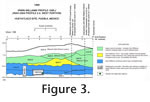 gravel (Unit K) that in part contained fragments of Xalnene tuff, and, below, gravel mixed with reworked pink clay (Unit L), thought by one of the authors (HEM) to have been derived from the underlying Amomoloc lake beds (Figure 5). The main excavation, which extended downward to the upper part of Unit J, was 3 m deep. gravel (Unit K) that in part contained fragments of Xalnene tuff, and, below, gravel mixed with reworked pink clay (Unit L), thought by one of the authors (HEM) to have been derived from the underlying Amomoloc lake beds (Figure 5). The main excavation, which extended downward to the upper part of Unit J, was 3 m deep.
Irwin-Williams worked at Hueyatlaco after, or during, a prolonged drought, when the level of the Valsequillo Reservoir was at 2049 m, or about 7 m below the lowest part of Hueyatlaco. Earlier in 1962 when she and Armenta Camacho made an initial survey and excavated the El Horno site (Irwin and Armenta Camacho, 1963), the water level was phenomenally low, at about 2030 m, as determined from photographs.
 Hence, González and her associates were misinformed when they say (2006, p. 612) that ". . . high water . . . plagued the archaeological excavations during the 1960s." Hence, González and her associates were misinformed when they say (2006, p. 612) that ". . . high water . . . plagued the archaeological excavations during the 1960s."
Information about the Irwin-Williams excavation of Hueyatlaco comes from three brief open-file progress reports to the
INAH (1962,
1964,
1966) and from
Irwin-Williams (1967a,
1967b,
1969,
1978), but she never prepared a final comprehensive report prior to her 1990 death. Also, her voluminous field records, including her field notes, all but two of her trench profiles, and thousands of her photographs and sketches, have not been located. However, M.A. Waters, the current Principal Investigator, may have had access to certain notebooks kept by workers. These notebooks are stored in the Smithsonian Institution archives.
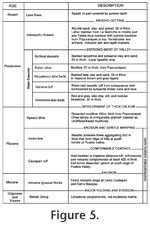 Also lost was the evidence from two "in block" specimens collected from Hueyatlaco in 1962 for museum display, where closely associated artifacts and fossil remains had been preserved in situ. The artifacts had been forcibly removed from the exhibits, thereby destroying the evidence of the association (Irwin-Williams, 1967b). Despite these losses, Irwin-Williams' detailed descriptions of the numerous stratigraphic features imply studious attention to the intricate features of the site. In this light, the basis of a remark by
González et al. (2006, p. 615) must be questioned. Speaking of Irwin-Williams, they reported that ". . . there was an apparent lack of understanding of the site formation processes at the time and of the sedimentology." Also lost was the evidence from two "in block" specimens collected from Hueyatlaco in 1962 for museum display, where closely associated artifacts and fossil remains had been preserved in situ. The artifacts had been forcibly removed from the exhibits, thereby destroying the evidence of the association (Irwin-Williams, 1967b). Despite these losses, Irwin-Williams' detailed descriptions of the numerous stratigraphic features imply studious attention to the intricate features of the site. In this light, the basis of a remark by
González et al. (2006, p. 615) must be questioned. Speaking of Irwin-Williams, they reported that ". . . there was an apparent lack of understanding of the site formation processes at the time and of the sedimentology."
After Irwin-Williams completed her work, 565 vertebrate fossil specimens and the artifacts were deposited with the INAH, where they presumably remain. However, except for one bifacial object (Irwin-Williams, 1978, Plate 1, Number 4), which was displayed, unlabeled, in 2003 in the national archaeological museum, the artifacts have not been located. Fortunately, plastic replicas of the artifacts are stored at the Smithsonian Institution (Payn 2006, time 0:10-0:11, 0:22, Stanford interview). This circumstance suggests that other items of the Irwin-Williams legacy may eventually come to light.
Irwin-Williams (1967, p. 339) judged that ". . . the materials employed in artifact manufacture were of nonlocal origin." This was also noted by González et al. (2006). The inference probably resulted from the site's lack of obsidian and the variable colors of the chert fragments that were utilized in the area. The modern surface is littered with fragments of obsidian tools and debitage.
Geologic Studies
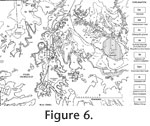 H. Malde, who had joined the Valsequillo Project as project geologist in 1964, completed two geologic maps during the 1964 and 1966 field seasons. One map (Figure 6) of the area around the Valsequillo Reservoir shows the Tetela Peninsula where the Hueyatlaco site is located. The other is a more general geologic map of the southern part of the Puebla Valley, reaching from Puebla and Cholula south to Atlixco. The original maps, not yet published, are stored in the Field Records Library of the USGS in Denver, Colorado. Copies have been widely distributed among participants in the Valsequillo investigations. J. Feinberg, Department of Geology and Geophysics, University of Minnesota is digitizing Malde's Valsequillo maps and field report for publication (Feinberg, personal commun. to VSM, 2008). H. Malde, who had joined the Valsequillo Project as project geologist in 1964, completed two geologic maps during the 1964 and 1966 field seasons. One map (Figure 6) of the area around the Valsequillo Reservoir shows the Tetela Peninsula where the Hueyatlaco site is located. The other is a more general geologic map of the southern part of the Puebla Valley, reaching from Puebla and Cholula south to Atlixco. The original maps, not yet published, are stored in the Field Records Library of the USGS in Denver, Colorado. Copies have been widely distributed among participants in the Valsequillo investigations. J. Feinberg, Department of Geology and Geophysics, University of Minnesota is digitizing Malde's Valsequillo maps and field report for publication (Feinberg, personal commun. to VSM, 2008).
In 1966 and 1968, Malde was joined by V. Steen, then a graduate student at the University of Idaho. Their geological investigations were mainly on La Malinche, a volcano just north of Puebla, in an effort to define the stratigraphy of the volcanic eruptions and to sample the tephra sequence for petrographic examination. No 14C dates had been possible for the Valsequillo sites, as no carbon was preserved there, and the bones were all permineralized. The working hypothesis was that tephra from the Malinche eruptions reached the Valsequillo area and that the sites could be dated indirectly by correlation of the tephra layers there with dated strata on the mountain. Previously, Malde's field work on La Malinche had disclosed many volcanic events and glacial features, as well as buried soils for which USGS radiocarbon dates in the ca 7,000 - 26,000 year age range exist (Malde, 1966;
Kelly et al., 1978). At the time it was thought that the Valsequillo sites, including Hueyatlaco, were on the order of 20,000 years old. Unfortunately, no volcanic units that could be reliably correlated with beds of volcanic ash at Valsequillo were found (Steen-McIntyre and Malde, 1970). Similarly, reconnaissance on the eastern slope of Popocatépetl volcano across the valley proved unrewarding.
In 1964 and 1966, C.E. Ray, a vertebrate paleontologist at the U.S. National Museum, collected fossil vertebrates at 25 localities in the Valsequillo area under the guidance of J. Armenta; one locality from which Ray collected was at Hueyatlaco itself. In 1964 Ray was joined by M. Pichardo, then a graduate student. Pichardo's interest in Valsequillo continued, and he has recently published papers on the horses (Pichardo, 2002,
2004) and the mammoths (Pichardo, 2005). Ray, however, soon delegated work on the Valsequillo vertebrates to R. Graham, then at the Illinois State Museum. Graham's research on Valsequillo fossils remains unpublished. The fossil collections have long since been returned to Mexico. A partial list of the fauna prepared by
Pichardo (2005, table 1) enumerates many larger forms but, curiously, none that are typical of a riparian or lacustrine habitat; animals such as beaver, muskrat, otter, waterfowl, amphibians, and fish are absent. Also, Arvicoline rodents (microtines) considered to be particularly precise for biochronological dating, have so far been generally overlooked, although
Armenta Comancho (1978,
figure 7-1) illustrated a small fully articulated rodent skeleton.
In the 1960s, the German Society for Scientific Research (Deutschen Forschungs-gemeinschaft) mounted a broad interdisciplinary study of the Puebla-Tlaxcala region that embraced geological and paleontological investigations. Conspicuous among the numerous book-length reports, is an opus by
Guenther et al. (1973). This report, along with less comprehensive reports by
Graham (1978) and
Pichardo (1999) that together assigned the Valsequillo fauna to the late Pleistocene, was summarized by
González et al. (2006). On the other hand, C.A. Repenning (Repenning, personal commun.
to HEM, 2002) took a broader view. After discussing the presence of Bison, which is limited to the "Barranca fauna" (from the Caulapan barranca some 5 km northeast of Hueyatlaco), Repenning pointed out that Smilodon gracilis from El Horno (Kurtén 1967), which is at the base of the Valsequillo
Gravels, is at least 840,000 years old. Repenning then referred to two pronghorn genera, Tetrameryx and Capromeryx, as being Irvingtonian age or older. To summarize, Repenning concluded that several forms of fauna from the Tetela Peninsula, where the Hueyatlaco and nearby El Horno sites are located, are distinctly NOT known to be as young as Bison.— According to
Bell et al. (2004), Bison is associated in North America with a maximum date of about 200 k.y.
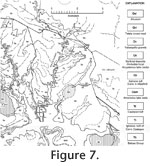 USGS geologist D.W. Taylor (Taylor, personal commun.
to HEM, 1967) described the ecology of fossil mollusks that were collected from alluvium at locality R14 in Barranca de Caulapan, a tributary of the Valsequillo Reservoir some 5 km northeast of Hueyatlaco, where one artifact had been found (Figure 7). His report is of interest because it classified the more than two dozen species according to habitat and age ranging from about 9 k.y. at the top of the section to more than 35,000 k.y. at the bottom, according to radiocarbon dates reported in 1966 by M. Rubin of the USGS radiocarbon laboratory (Malde, 1966;
Kelly et al., 1978). Taylor concluded that the environment changed from perennial fresh water in the lower, coarser part of the section to seasonal or intermittent flow at the top. None of the species is extinct, but a few of the forms are not known to live presently in the area. USGS geologist D.W. Taylor (Taylor, personal commun.
to HEM, 1967) described the ecology of fossil mollusks that were collected from alluvium at locality R14 in Barranca de Caulapan, a tributary of the Valsequillo Reservoir some 5 km northeast of Hueyatlaco, where one artifact had been found (Figure 7). His report is of interest because it classified the more than two dozen species according to habitat and age ranging from about 9 k.y. at the top of the section to more than 35,000 k.y. at the bottom, according to radiocarbon dates reported in 1966 by M. Rubin of the USGS radiocarbon laboratory (Malde, 1966;
Kelly et al., 1978). Taylor concluded that the environment changed from perennial fresh water in the lower, coarser part of the section to seasonal or intermittent flow at the top. None of the species is extinct, but a few of the forms are not known to live presently in the area.
The dated Caulapan sequence also contained several tephra horizons and a single worked chert flake from near the base, associated with a 14C age of about 22 k.y. (sample 66-R-14, E, W-1895,
Malde, 1966;
Kelly et al., 1978) and a similar U-series age (Szabo et al., 1969). There was hope that the tephra layers would correlate with the volcanic units exposed at the reservoir sites and that their age could be implied that way, but again, disappointment. No correlation was possible.
The Early Uranium-series Dates
In 1969, B. Szabo of the USGS measured several uranium-series ages on specimens from Valsequillo (Szabo et al., 1969;
Steen-McIntyre et al., 1981). This technique was then in its infancy for application to terrestrial deposits, and Szabo chose to analyze a variety of materials, including a bone and a tooth fragment from Valsequillo; proboscidean bones from Barranca de Caulapan (where shells had previously been dated by the radiocarbon method); a bison bone from the Lindenmeir site in Colorado; and a bison skull from an alluvial terrace, also in Colorado. In general, his ages for Caulapan and the Colorado samples agreed with other determinations, but the results for the Valsequillo
specimens were considered by Irwin-Williams to be wildly too old—in a word, "impossible" (Irwin-Williams, personal commun. to HEM, 1969). In particular, bone from an articulated camel pelvis in Unit C, a layer with bifacial tools, gave a protactinium-231 age greater than 180 k.y. and an open-system thorium-230 age of 245 ± 40 k.y. Furthermore, a tooth from a butchered mastodon at the El Horno site, 16 m topographically and stratigraphically lower than Hueyatlaco (Figure 1), gave a protactinium-231 age greater than 165 k.y. and an open-system thorium-230 age greater than 280 k.y. Because Irwin-Williams judged these dates to be incompatible with her archaeological findings, and indeed with all prior archaeological thought (Szabo et al., 1969;
Irwin-Williams, 1981), she essentially dropped interest in Valsequillo. The Valsequillo dates were also rejected by González and her associates (Gonzalez et al., 2006) on the grounds that leaching or recent uptake of uranium by the bones was possible, even though Szabo (Szabo et al., 1969;
Steen-McIntyre et al., 1981;
Malde and Steen-McIntyre, 1981) had used an open-system model for some measurements and further obtained results essentially concordant with ages derived by independent means.
 Fission-Track Dates Fission-Track Dates
Three volcanic deposits are preserved at Hueyatlaco, topographically above the layers with artifacts. The oldest layer is the Hueyatlaco ash, a 1 m thick layer 2.5 m above the highest artifact-containing bed. Next is the Tetela brown mud, a lahar 1 m thick and 4 m above the Hueyatlaco ash. The Tetela brown mud contains abundant pumice fragments of varying size. Above the Tetela brown mud is the Buena Vista lapilli, an air fall layer as much as 30 cm thick that is preserved in places directly on the Tetela brown mud (Figure 8,
Figure 9, and
Figure 10). In 1973, one author (CWN) using small samples of 10 grains each, obtained 2-sigma fission-track ages of 370 ± 200 k.y. for zircons from the Hueyatlaco ash and 600 ± 340 k.y. for zircons from pumice in the Tetela brown mud (Steen-McIntyre, 1981,
1985;
Steen-McIntyre et al.,1981). The small numbers of fossil tracks counted (12, 13) account for the relatively large uncertainty. Naeser's results were later confirmed by R. Donelick and K. Farley (Payn,
2006, Farley and Donelick interviews).
González et al. (2006) rejected Naeser's fission-track ages relying instead on radiocarbon dates from Barranca de Caulapan (Szabo et al., 1969,
Kelly et al., 1978) that are judged by them to be more compatible with archaeological thought. They further comment (p. 617) that Naeser's dates, together with the
Szabo et al. (1969) uranium-series results, are ". . . rejected by the majority of archaeologists and paleontologists."
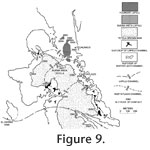 Tephra Hydration Ages, Mineral Etching Tephra Hydration Ages, Mineral Etching
Between 1970 and 1973, Steen-McIntyre continued her examination of pumice and ash from the Hueyatlaco area and the flanks of the surrounding volcanoes. She examined hundreds of tephra samples with the same results: no recognized correlations. Only gradually did the idea surface that Szabo's U-series ages (Szabo et al., 1969) could be correct, and that correlations were not possible because tephra layers correlative with the Hueyatlaco material were much older and deeply buried in the flanks of the volcanoes, making sampling impossible.
As a parallel research project, Steen-McIntyre had been studying Friedman's obsidian hydration dating technique, which had been used to rough-date obsidian artifacts (Friedman and Long, 1976;
Friedman and Smith, 1960). Not only could the same technique be used on tiny, silica-rich volcanic-glass shards, but
Roedder and Smith (1965) found that after the volcanic glass was completely hydrated, water continued to accumulate, molecule by molecule, in bubble cavities enclosed in the glass, a process that could take millions of years.
 Combining these two techniques, which she called the tephra hydration dating method, Steen-McIntyre found that, indeed, the extent of hydration and superhydration of the glass shards were very different for the suite of samples collected on the volcanoes and from the Hueyatlaco suite. Dated samples from La Malinche volcano, ranging in age from roughly 7 to 26 k.y., were mostly incompletely hydrated, with only the oldest specimens showing complete hydration and only a minute amount of water in the tip of small spindle-shaped vesicles. In contrast, all of the volcanic glass samples from the Hueyatlaco suite were completely hydrated and showed considerably more water in the vesicles (Steen-McIntyre, 1975,
1977,
1981,
1985,
2006). Further comparison with silica-rich volcanic glass shards dated from other areas placed the Hueyatlaco tephra samples at roughly 250 k.y. (Steen-McIntyre, 1977,
2006;
Steen-McIntyre et al.,1981). Combining these two techniques, which she called the tephra hydration dating method, Steen-McIntyre found that, indeed, the extent of hydration and superhydration of the glass shards were very different for the suite of samples collected on the volcanoes and from the Hueyatlaco suite. Dated samples from La Malinche volcano, ranging in age from roughly 7 to 26 k.y., were mostly incompletely hydrated, with only the oldest specimens showing complete hydration and only a minute amount of water in the tip of small spindle-shaped vesicles. In contrast, all of the volcanic glass samples from the Hueyatlaco suite were completely hydrated and showed considerably more water in the vesicles (Steen-McIntyre, 1975,
1977,
1981,
1985,
2006). Further comparison with silica-rich volcanic glass shards dated from other areas placed the Hueyatlaco tephra samples at roughly 250 k.y. (Steen-McIntyre, 1977,
2006;
Steen-McIntyre et al.,1981).
In addition to the extent of superhydration of the volcanic glass shards from the Hueyatlaco tephras, hypersthene phenocrysts found in them showed excessive etching by groundwater (Steen-McIntyre, 1977,
1985;
Steen-McIntyre et al., 1981). By contrast, hypersthene phenocrysts from tephra samples from the region dated at 22-24 k.y. showed only incipient etching. Younger units completely lacked etching (P.W. Lambert, personal commun.
to VSM, 1973.).
The 1973 Geologic Excavation
 In 1966, J.L. Lorenzo dug two parallel east-west trenches some 10 m south of the area excavated by Irwin-Williams (Irwin-Williams, 1967b;
Lorenzo, 1967). Lorenzo's southernmost trench proceeded eastward from the Tetela brown mud and reached a depth, in places, as much as 5 m below the Hueyatlaco ash In 1966, J.L. Lorenzo dug two parallel east-west trenches some 10 m south of the area excavated by Irwin-Williams (Irwin-Williams, 1967b;
Lorenzo, 1967). Lorenzo's southernmost trench proceeded eastward from the Tetela brown mud and reached a depth, in places, as much as 5 m below the Hueyatlaco ash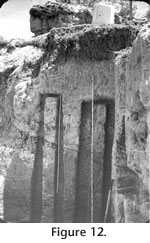 (Figure 11). In 1973 two of the authors (HEM and VSM) connected Lorenzo's trench with the area excavated by Irwin-Williams to determine the stratigraphic relationship between the Hueyatlaco ash and higher deposits to the layers containing her artifacts. They collaborated with R. Fryxell of Washington State University. Fryxell brought to Hueyatlaco his considerable experience mapping microstratigraphy at archaeological sites and his knowledge of preserving important artifacts in situ in blocks of undisturbed sediment. Fryxell's skill was particularly useful in collecting stratigraphic monoliths from the trench walls, stabilized sediment sections up 2 m tall that sampled the total exposed section at the site (Figure 12). These monoliths have since proven to be a valuable resource. Fryxell also took many high-resolution photographs of the excavation, some of which are discussed here. Although Fryxell died in 1974, his Hueyatlaco research unfinished, his profile drawings, photographs, and the
straigraphic monoliths survived. (Figure 11). In 1973 two of the authors (HEM and VSM) connected Lorenzo's trench with the area excavated by Irwin-Williams to determine the stratigraphic relationship between the Hueyatlaco ash and higher deposits to the layers containing her artifacts. They collaborated with R. Fryxell of Washington State University. Fryxell brought to Hueyatlaco his considerable experience mapping microstratigraphy at archaeological sites and his knowledge of preserving important artifacts in situ in blocks of undisturbed sediment. Fryxell's skill was particularly useful in collecting stratigraphic monoliths from the trench walls, stabilized sediment sections up 2 m tall that sampled the total exposed section at the site (Figure 12). These monoliths have since proven to be a valuable resource. Fryxell also took many high-resolution photographs of the excavation, some of which are discussed here. Although Fryxell died in 1974, his Hueyatlaco research unfinished, his profile drawings, photographs, and the
straigraphic monoliths survived.
 The 1973 excavation confirmed the stratigraphy described by Irwin-Williams, namely that the layers with bifacial artifacts (Units C and E) overlaid the layer with unifacial artifacts (Unit I). Of greater interest, however, was the discovery of a layer called "sand grading laterally to clay" that continued beneath the Hueyatlaco ash. This layer was mapped as resting on Units B, C, and E, placing all the artifacts below the Hueyatlaco ash and, therefore, also beneath the Tetela brown mud and the Buena Vista lapilli (Figure 13,
Figure 14,
Figure 15). (Steen-McIntyre et al., 1981). The 1973 excavation confirmed the stratigraphy described by Irwin-Williams, namely that the layers with bifacial artifacts (Units C and E) overlaid the layer with unifacial artifacts (Unit I). Of greater interest, however, was the discovery of a layer called "sand grading laterally to clay" that continued beneath the Hueyatlaco ash. This layer was mapped as resting on Units B, C, and E, placing all the artifacts below the Hueyatlaco ash and, therefore, also beneath the Tetela brown mud and the Buena Vista lapilli (Figure 13,
Figure 14,
Figure 15). (Steen-McIntyre et al., 1981).
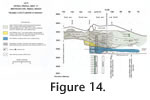 In a further attempt to establish a chronology for the Hueyatlaco deposits, two oriented samples for paleomagnetic measurement were collected from the Hueyatlaco ash and from underlying clay (Figure 8 and
Figure 13). These samples were both found to exhibit normal polarity (Liddicoat et al., 1981), interpreted to represent the Brunhes magnetozone. However,
González et al. (2006) consider this attempt to place the Hueyatlaco site within the paleomagnetic time scale unsuccessful. In a further attempt to establish a chronology for the Hueyatlaco deposits, two oriented samples for paleomagnetic measurement were collected from the Hueyatlaco ash and from underlying clay (Figure 8 and
Figure 13). These samples were both found to exhibit normal polarity (Liddicoat et al., 1981), interpreted to represent the Brunhes magnetozone. However,
González et al. (2006) consider this attempt to place the Hueyatlaco site within the paleomagnetic time scale unsuccessful.
New Ages for Hueyatlaco Volcanic Ash Deposits
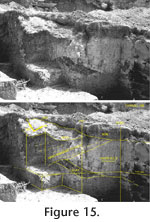 In 1997, M. Payn, an engineer, organized further fieldwork at Hueyatlaco, and began a video record of the work. One of his first tasks was to obtain additional dates from the volcanic deposits. Consequently, Steen-McIntyre aided A.L. Martín, a volcanologist at the Mexican National University (UNAM), in collecting samples from the Hueyatlaco ash and what they mistakenly thought to be an outcrop of Buena Vista lapilli. Later petrographic work by D. Geist, University of Idaho, showed the latter to be a somewhat younger lapilli of andesitic composition (Figure 9). In 1997, M. Payn, an engineer, organized further fieldwork at Hueyatlaco, and began a video record of the work. One of his first tasks was to obtain additional dates from the volcanic deposits. Consequently, Steen-McIntyre aided A.L. Martín, a volcanologist at the Mexican National University (UNAM), in collecting samples from the Hueyatlaco ash and what they mistakenly thought to be an outcrop of Buena Vista lapilli. Later petrographic work by D. Geist, University of Idaho, showed the latter to be a somewhat younger lapilli of andesitic composition (Figure 9).
In 1998-1999, T.A. Dumitru of Stanford University concentrated zircon crystals from these samples, and R.A. Donelick, then at Rice University, determined fission track ages of the zircon crystals. Zircon (U-Th)/He isotopic ages for the Hueyatlaco ash were determined by K.A. Farley of the California Institute of Technology. The dating had been conducted with contracts from M. Payn, to whom these investigators independently reported their results. Later they wrote a joint preliminary report and submitted it to Payn. These dates are discussed in the report and in a Payn video (2006, OCLC number 76906782,).
Donelick obtained a fission-track age of 212 ± 47 k.y. (212 ± 94 k.y. two standard deviations, CWN) from one sample of Hueyatlaco ash zircons and an age of 250 ± 52 k.y. (250 ±104 k.y. two standard deviations, CWN) for a second sample. Using two other splits, Farley got a zircon (U-Th)/He isotopic age of from 413 to 505 k.y. for one split and from 406 to 504 k.y. for the other, indicating excellent agreement between the two samples. Donelick determined fission-track ages of 232 ± 86 k.y. (232 ±172 k.y. two standard deviations, CWN) and 303 ± 58 k.y. (303 ±116 k.y. two standard deviations, CWN) for two splits from the andesitic lapilli (Payn, 2006, time ca 0:40-0:50, Donelick and Farley interviews.)
These are fairly consistent results in the realm of isotopic dating, considering that the samples are relatively young; but the question of why the reported ages don't agree more closely remains. However, Donelick and Farley, in their report to M. Payn, pointed out that the fission-track dates are a minimum and that the zircon (U-Th)/He method is inherently more precise. Donelick agreed with the judgment that the helium dates were more accurate, but in the end they chose to report, impartially, an age for the Hueyatlaco ash between 212 ± 47 k.y.(212 ± 94 k.y. two standard deviations, CWN) and 406 - 505 k.y., thus covering the full range of the analyses. Even so, their final word in the report was that "the true age of these zircons lies closer to 0.406 Ma than to the upper limit" (Payn, personal commun. 1999.)
Early Diatom Studies by S.L. VanLandingham
About 30 years ago, diatom paleontologist S.L. VanLandingham, stumbled onto a reference slide of diatoms at the California Academy of Sciences in San Francisco, which had been scraped from diatomite inside a fossil human skull. The Dorenberg skull, which has been missing since the World War II bombing of Leipzig, had been collected south of the city of Puebla in 1899. VanLandingham identified the diatoms as being of Sangamon (or Late Tyrrhenian) age, about 80-220 k.y.). Because such knowledge being made public has been anathema to other careers, VanLandingham kept these data to himself until 1999, when he first read about Valsequillo in
Cremo and Thompson's (1993) popular book on Early Man. He then contacted Steen-McIntyre, who had collected sediment samples from Hueyatlaco in 1973 (Figure 13). VanLandingham identified Sangamon aged diatoms in these samples. Furthermore, he found similar diatom taxa in his study of cores and samples that had been collected by Malde in the 1960s. (VanLandingham, 2004). He joined the Hueyatlaco field party in 2001.
The 2001 Field Season
Under the patronage of M. Payn, new archaeologic excavations were conducted at Hueyatlaco in 2001. A number of fossil vertebrates were found, but only a single problematical flake was recovered (Ochoa-Castillo et al., 2003). However, Steen-McIntyre and petroleum geologist R. McKinney conducted geological studies, C. Hardaker video-recorded the work, and VanLandingham sampled and examined for diatoms. The Mexican contingent consisted of J. Arroyo-Cabrales, a vertebrate paleontologist from the INAH; P. Ochoa-Castillo, a ceramic specialist at the INAH; A.L. Martín, a UNAM volcanologist; and M. Pérez-Campa, an administrative archaeologist at the INAH. McKinney gave particular attention to collecting samples for thin section preparation and petrographic analyses. In the Hueyatlaco ash, McKinney found flattened bubble cavities, indicating that the material was hot when it landed, confirming its origin as an air fall.
The 2001 dig focused on three issues: 1) to dispel a charge of planting artifacts put forth by
Lorenzo (1967); 2) to test the fission-track ages reported by Naeser (Steen-McIntyre, 1981,
1985;
Steen-McIntyre et al.,1981); and (3) to allay the suspicion that the artifacts and bones had been redeposited.
In the eyes of the Mexican contingent, the unethical procedure of planting artifacts was ruled out by the continuity of the sediment. The fission-track age of the Hueyatlaco ash was confirmed by its similarity to new fission-track determinations and by the helium isotopic ages described above. Redeposition was refuted by the presence of articulated bones, suggesting deposition under relatively tranquil sedimentary conditions, and confirming conformable bedding in the geologic section.
Un-crating and Sampling the 1973 Monoliths
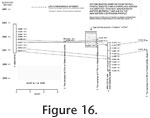 The stratigraphic monoliths originally collected at Hueyatlaco in 1973 by Fryxell and Steen-McIntyre, and which had been packed in five wooden crates, took several years to reach Denver. The fate of a duplicate set collected for the INAH is still unknown. In Denver, the sealed crates languished for several more years in various storage areas at the USGS Denver complex. Eventually, they were released to the care of Steen-McIntyre. The monoliths remained with her until 2002, when VanLandingham transported them to his laboratory in Midland, Texas. There, the opening of the crates was recorded on video, and the contents were examined and sampled by VanLandingham, Steen-McIntyre, and McKinney. The stratigraphic monoliths originally collected at Hueyatlaco in 1973 by Fryxell and Steen-McIntyre, and which had been packed in five wooden crates, took several years to reach Denver. The fate of a duplicate set collected for the INAH is still unknown. In Denver, the sealed crates languished for several more years in various storage areas at the USGS Denver complex. Eventually, they were released to the care of Steen-McIntyre. The monoliths remained with her until 2002, when VanLandingham transported them to his laboratory in Midland, Texas. There, the opening of the crates was recorded on video, and the contents were examined and sampled by VanLandingham, Steen-McIntyre, and McKinney.
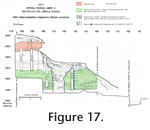 Each monolith, still wrapped in burlap and tied to the board used to remove it from the trench wall in 1973, was mapped and photographed to provide an accurate record for selecting diatom samples as well as for other purposes. Monoliths WSU73V10, WSU73V15 and V16 were closely sampled for diatoms (Figure 14,
Figure 16, and
Figure 17). A sample from monolith WSU73V10 (Unit I,
Figure 3) was sent to C. Falguéres at the Institut de Paleontologie Humaine, Paris, for possible Electron-Spin-Resonance (ESR) dating. C. Repenning was examining fossil hash from Units G, I, and J in monolith WSU73V10 provided by VanLandingham when he was killed. Each monolith, still wrapped in burlap and tied to the board used to remove it from the trench wall in 1973, was mapped and photographed to provide an accurate record for selecting diatom samples as well as for other purposes. Monoliths WSU73V10, WSU73V15 and V16 were closely sampled for diatoms (Figure 14,
Figure 16, and
Figure 17). A sample from monolith WSU73V10 (Unit I,
Figure 3) was sent to C. Falguéres at the Institut de Paleontologie Humaine, Paris, for possible Electron-Spin-Resonance (ESR) dating. C. Repenning was examining fossil hash from Units G, I, and J in monolith WSU73V10 provided by VanLandingham when he was killed.
The 2004 Field Season
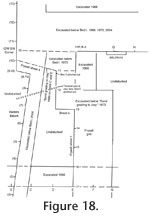 Beginning in the 1990s, J.L. and R. Cramer of Denver established five archaeological research endowments for Paleoindian studies at western universities, one of which was Texas A&M University, where M. Waters manages the funds. Waters visited Hueyatlaco with J. Arroyo-Cabrales in 2003, and a new project was born. He located some of Irwin-Williams' files at the Smithsonian in 2003 and launched an excavation in May and June 2004, with colleagues Arroyo-Cabrales and P. Ochoa-Castillo. Steen-McIntyre and Malde joined the field party, and A.L. Martin made several brief visits. The 2004 excavation opened three trenches: one at the south boundary of the Irwin-Williams dig; another perpendicular to this at a place 7 m east of Irwin-Williams' southwest corner; and, of special importance for this discussion, a trench named the 4-Extension Trench that exhumed the Irwin-Williams west wall and extended more or less southward to the Hueyatlaco ash (Figure 18 and
Figure 19). The Irwin-Williams west wall also had been exhumed in 1973, as had some of her south wall. The 4-Extension Trench angled a bit to the southwest in order to end at an outcrop of the ash, and it missed the Irwin-Williams southwest corner by 0.75 m. Beginning in the 1990s, J.L. and R. Cramer of Denver established five archaeological research endowments for Paleoindian studies at western universities, one of which was Texas A&M University, where M. Waters manages the funds. Waters visited Hueyatlaco with J. Arroyo-Cabrales in 2003, and a new project was born. He located some of Irwin-Williams' files at the Smithsonian in 2003 and launched an excavation in May and June 2004, with colleagues Arroyo-Cabrales and P. Ochoa-Castillo. Steen-McIntyre and Malde joined the field party, and A.L. Martin made several brief visits. The 2004 excavation opened three trenches: one at the south boundary of the Irwin-Williams dig; another perpendicular to this at a place 7 m east of Irwin-Williams' southwest corner; and, of special importance for this discussion, a trench named the 4-Extension Trench that exhumed the Irwin-Williams west wall and extended more or less southward to the Hueyatlaco ash (Figure 18 and
Figure 19). The Irwin-Williams west wall also had been exhumed in 1973, as had some of her south wall. The 4-Extension Trench angled a bit to the southwest in order to end at an outcrop of the ash, and it missed the Irwin-Williams southwest corner by 0.75 m.
 Also, three exploratory pits were dug west of the west wall, and an earlier Irwin-Williams pit in the eastern part of Hueyatlaco was reopened to obtain a sample of Xalnene tuff. Also, three exploratory pits were dug west of the west wall, and an earlier Irwin-Williams pit in the eastern part of Hueyatlaco was reopened to obtain a sample of Xalnene tuff.
During the 2004 season, Steen-McIntyre collected samples for petrographic study (by McKinney) and for study of diatoms (by VanLandingham). A duplicate set of her samples also was submitted to the INAH for diatom analysis.
S.L. Forman of the University of Illinois at Chicago collected samples for, as it turned out, unsuccessful thermoluminescence dating. Also, P.R. Renne and K.B. Knight of the Berkeley Geochronology Center, California, collected samples of Hueyatlaco ash, Tetela brown mud pumice, Buena Vista lapilli, and Xalnene tuff for argon-argon dating (Figure 10).
The 4-Extension Trench showed that Irwin-Williams' Unit I, the layer that had produced unifacial artifacts, is about 4 m stratigraphically beneath the Hueyatlaco ash. The channel deposit Units C and E with bifacial tools, however, and the associated sterile Units B and D, were considered by Waters to be inset and unconformable with respect to the Hueyatlaco ash and the higher deposits, and much younger. This interpretation differs from the conformable stratigraphy interpreted by us in 1973 and reconfirmed in 2001. This conflict has led to the current debate, discussed in this paper.
The González Ages
González et al. (2006,
Table 1) proposed a new series of ages for the Valsequillo Basin sequence and for the Hueyatlaco artifacts that are much younger—8-40 k.y.—than our ages discussed in this paper This series was based on samples collected from Barranca Caulapan and on an erroneous age of ca 40 k.y. for the Xalnene basaltic ash/tuff from near the base of the exposed basin sequence. This last age was later retracted in favor of Renne's 1.3 m.y. argon-argon age (Renne et al., 2005;
Feinberg et al., 2009;
Mark et al., 2010),
González et al. (2006) dated four shell samples from the Caulapan section using the radiocarbon AMS method and four samples from a mammoth tooth collected there using ESR/U-Series analysis. They (González et al., 2006, page 216) concluded "The Valsequillo Gravels in the Barranca Caulapan range in age from 9 to over 38 ka BP. These dates are more or less in agreement with the dates obtained in the 1960s and 1970s (Szabo et al., 1969, figure 5A)." They were unable to collect samples from the reservoir sites because the water level was too high, but they believed their Caulapan ages would apply there, assuming the (erroneous) 40 k.y. age for the Xalnene basaltic ash/tuff uncovered at the base of the Hueyatlaco excavation.
|

















